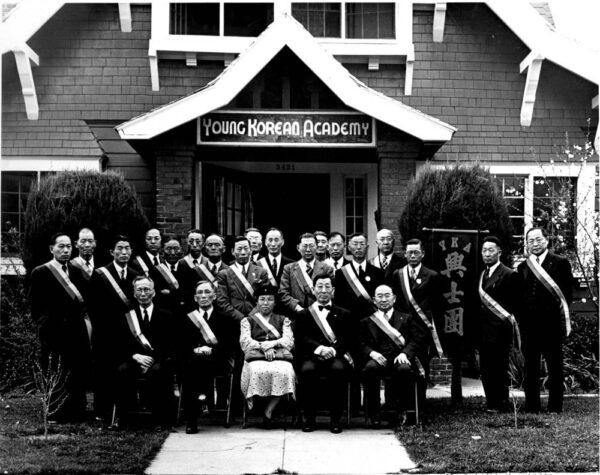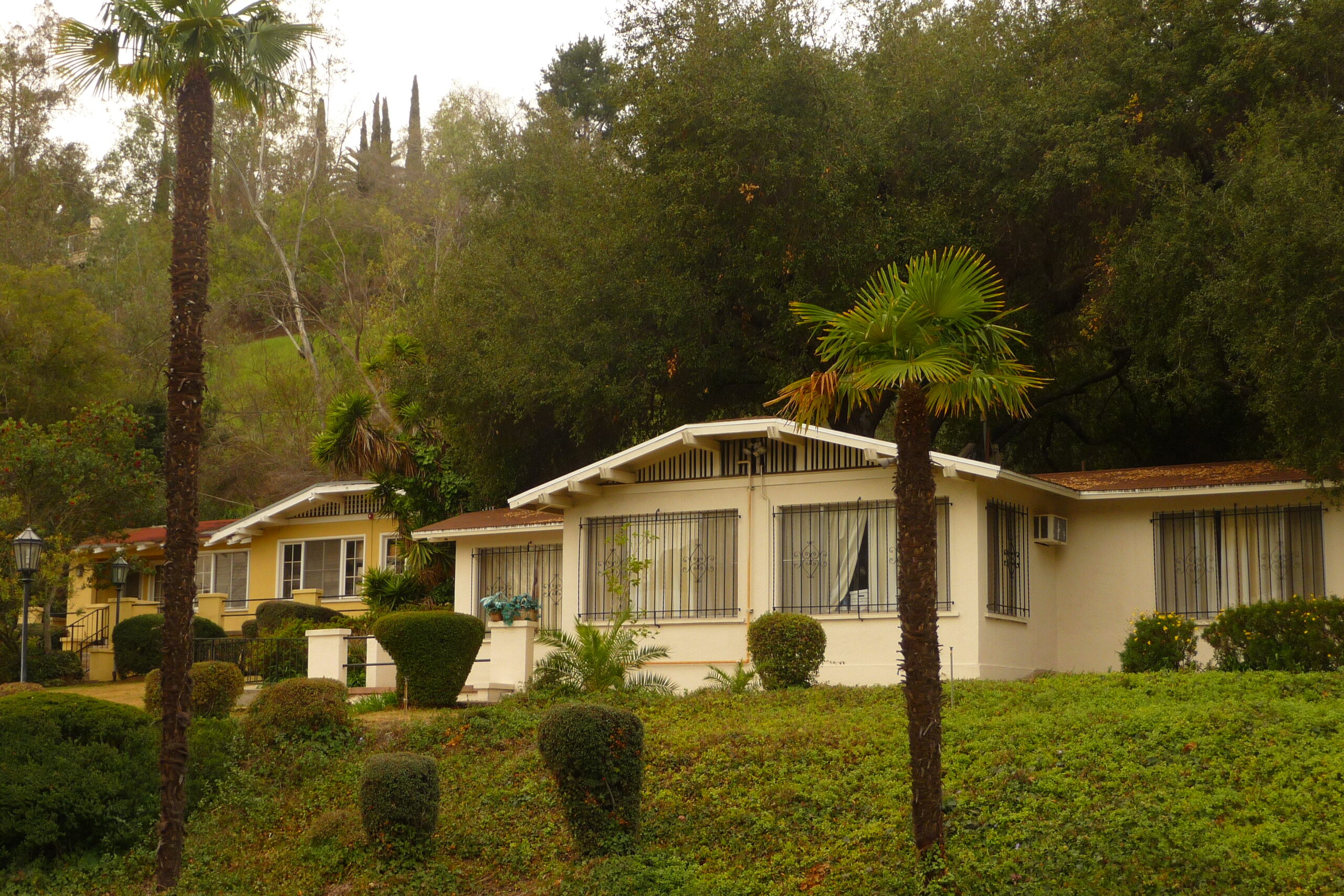
Place
Hung Sa Dahn
The Craftsman-style residence served as the longtime headquarters of Hung Sa Dahn/Young Korean Academy, founded by Dosan Ahn Chang Ho, Korean independence activist.
Saved
The property at 3421-3423 South Catalina Street in Expo Park was designated a Historic-Cultural Monument in 2023.


Place Details
Address
Get directions
Style
Decade
Property Type
Government Officials
Community

Hung Sa Dahn/Young Korean Academy. | Korean American Digital Archive, USC Libraries Digital Collections.
Overview
This Craftsman-style residence in Expo Park served as the longtime headquarters of Hung Sa Dahn, also known as the Young Korean Academy, an important Korean American civic organization established by Dosan Ahn Chang Ho, a singularly important figure at the local, state, and national level as well as in modern Korean history.
In 2021, Asian & Pacific Islander Americans in Historic Preservation (APIAHiP) and the Los Angeles Conservancy worked together to prepare a City of Los Angeles Historic-Cultural Monument (HCM) application and nominate Hung Sa Dahn. Without this action, it is unlikely the structure would still be standing today.
Until recently, the property was threatened by a redevelopment project. On January 31, 2023, the Government of the Republic of Korea finalized a deal to purchase the property, saving it from demolition!
A plan to preserve the property and share the site’s role in the Korean independence movement will be developed. This action marks an important moment with another government stepping in to preserve its Korean American heritage in America. To read the full press release, click here.
About This Place
About This Place
3421-3423 South Catalina Street has been identified in SurveyLA’s Korean American Historic Context Survey as eligible for listing as a Los Angeles Historic-Cultural Monument (HCM) as the longtime headquarters of Hung Sa Dahn, a significant Korean American civic organization in Los Angeles.
The property is exemplary as a rare and enduring Korean American institutional property in Los Angeles. 3421-3423 South Catalina Street was the location from which Hung Sa Dahn operated from 1929 to 1979, which is the period of significance for the property. The buildings are extant, intact, and rare examples of early institutional properties associated with Korean American immigration, settlement, and development in Los Angeles.
The property is also significant for its direct association with the life of historic personage, Dosan Ahn Chang Ho, a singularly important figure in Korean American history at the local, state, and national level, and in modern Korean history more broadly. Although Ahn was imprisoned abroad in Korea at the time of Hung Sa Dahn’s acquisition of the property in 1936 and died two years later before he could return home to Los Angeles, he and his teachings are integral to the organization’s existence, including its period of significance at 3421-3423 South Catalina Street. Furthermore, the building’s acquisition was facilitated through his direct efforts and served as the first and only standalone headquarters of Hung Sa Dahn in Los Angeles.
Ahn Chang Ho, Korean independence activist and prominent leader of the early Korean American community in the U.S., founded Hung Sa Dahn in San Francisco in 1913. The organization’s mission was to build civic and political leadership capacity for the Korean independence movement from Japanese colonial rule (1910-1945). Ahn’s teachings beyond the goal of independence promoted Korean sovereignty through democracy. Its membership was varied, consisting of day laborers, farmworkers, and shopkeepers, as well as ambassadors and diplomats.
When Ahn and his family moved to Los Angeles in 1914, Hung Sa Dahn’s headquarters moved to Los Angeles. It first operated out of the Ahn family home at 1411 West 4th Street, then by 1917 at 106 North Figueroa Street (neither buildings are extant). The property at 3421 South Catalina Street was leased by Hung Sa Dahn in 1929, then purchased in 1932 as its first standalone headquarters.
Hung Sa Dahn’s membership grew as the Korean community in Los Angeles began expanding and coalescing southward in the neighborhood surrounding USC in the 1920s and 1930s. USC students, both second-generation Korean Americans and international students from Korea, were among its members. Men and women alike were welcomed to join the organization, reflecting Ahn’s progressive views and belief that gender equality would contribute to better outcomes for society at large.
Given the discrimination in employment and lack of opportunity to purchase property, the economic situation for many Korean immigrants in the community was dire, particularly as they grew older. One of Hung Sa Dahn’s functions was to provide housing assistance to members who needed it, particularly local university students and elder founding members. Three bedrooms were located upstairs on the second floor, while the downstairs contained a large meeting room, office, kitchen, and guest bedroom.
In 1958, the organization further expanded its capacity by constructing a detached two-story duplex to the rear of their existing building. The intent was to provide housing for elder founding members of the organization. Plans for the project were approved in 1958, with a valuation of $10,000, a significant sum at the time. Dr. Marn Cha, professor emeritus of political science at California State University, Fresno, arrived from South Korea in 1957 to attend USC, and was inducted as a Hung Sa Dahn member in 1960. He recalls that an elderly couple, who he believed were founding members, lived in one of the two units.
Hung Sa Dahn continued to serve as a political voice following liberation. South Korea experienced political and social turmoil in the 1950s-1980s, both on account of the Korean War and subsequent authoritarian rule, which ran counter to Hung Sa Dahn’s core philosophies. The organization’s focus turned to promoting democratic governance through education and study of Ahn Chang Ho’s teachings, which were believed to be universal and applicable in a variety of political contexts. Therefore, although Hung Sa Dahn’s sphere of influence shifted, it did not wane.
In 1979, the Hung Sa Dahn property was sold by the organization for financial reasons. The organization is still in active operation today throughout its 35 chapters in South Korea, the U.S., and elsewhere in the world.
Our Position
In 2021, Hung Sa Dahn faced imminent demolition as part of a redevelopment by its then owner Tripalink. At that critical time, Asian & Pacific Islander Americans in Historic Preservation (APIAHiP) and the Los Angeles Conservancy partnered to nominate this rare and historically significant property as a Historic-Cultural Monument (HCM). The nomination helped decision-makers understand the significance of the property and brought the owner and stakeholders together to find a preservation-based outcome.








